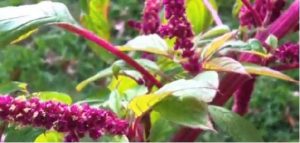Amaranth, Red Garnet

Geography/History:
In ancient Greece, the amaranth (also called chrysanthemum and helichrysum) was sacred to
Ephesian Artemis. It was supposed to have special healing properties, and, as a symbol of immortality, was
used to decorate images of the gods and tombs. In legend, Amarynthus was a hunter of Artemis and king
of Euboea; in a village of Amarynthus, of which he was the eponymous hero, there was a famous temple of
Artemis Amarynthia or Amarysia. It was also widely used by the Chinese for its healing chemicals, curing
illnesses such as infections, rashes, and migraines.
Nutritional Value:
Cooked amaranth leaves are a good source of vitamin A, vitamin C, and foliate; they are also a complementing
source of other vitamins such as thiamine, niacin, and riboflavin, plus some dietary minerals Amaranth seeds
contain lysine, an essential amino acid, limited in other grains or plant sources. Most fruits and vegetables do
not contain a complete set of amino acids, and thus different sources of protein must be used. Amaranth seeds
are therefore promising complement to common grains such as wheat germ, oats, corn because these
common grains are abundant sources of essential amino acids found to be limited in amaranth.
Sun: Full Sun
Spacing: 10 – 11”
Height: 24 – 36?
Optimum Soil Ph: 5.5-7.0, Ideal 6.0-6.5
Days To Maturity: 25 – 55
Sowing Method: Start Indoors
Planting/Growing Tips:
Seeds should be sown in spring and can be started in an indoor seed raising tray earlier, if kept warm enough.
The seeds require a soil temperature of at least 20 C to germinate. Sow or plant out with spacing of 10 inches
and water well until the plants are established. It takes 55 days from seed to harvest but young leaves can be
picked from as early as 25 days. Flowers should appear on straight stems from mid-summer until the weather
grows too cold and/or frosty. The colors should become more intense as the plant ages.
